Etsy is an online marketplace where there are a lot of potential buyers, around 96.3 million of them, who are actively looking for products similar to what you offer.
No matter if you’re an experienced small business owner or someone new to selling your creations, starting a store on Etsy can be an exciting step toward turning your hobby or creative passion into a profitable business.
In this guide, we will give you all the important information you need to know about making money on Etsy. Whether you want to make some extra income alongside your regular job or aspire to turn your craft into a full-time career, we’ve got you covered.
Table of Contents
How Much Money Can You Make on Etsy?
Well, it really depends on you. Until you start selling, it’s tough to predict how much you’ll make. Some Etsy sellers pull in over $50,000 annually, while others might only make a few thousand dollars.
Becoming an Etsy millionaire is quite unlikely, but don’t be discouraged. With some simple tips, you can easily earn a nice side income while pursuing something you love.
As an example, I dabbled in selling digital products on Etsy last year. Here’s the breakdown:
- Monthly Earnings (before expenses): $500-$5,000
- Net Income (after covering materials, shipping, research, tools, licensing, and other costs): Not a whole lot.
The best part? I only put in about 2-3 hours per week. I use offsite ads, skip Etsy ads, and only promote my shop through Instagram.
How to Sell on Etsy and Make Money
Step 1: Choose a Profitable Niche
When you’re starting your Etsy shop, one of the first things to do is choosing the right product category and niche.
Think of a niche as a specific market for certain products or services. For example, if you’re passionate about green tea, that could be your niche within the beverage industry.
To succeed on Etsy, it’s essential to focus on something you’re either skilled in or truly passionate about. Trying to sell in a niche that doesn’t interest you can be challenging. So, take a moment to think: What excites you? What are you good at? Your niche should align with your personal interests and skills.
This is particularly helpful if you’re an artist. Your unique talents can define your niche, making it a great way to make money on Etsy.
Once you’ve identified your niche, it’s time to see if there’s demand for it. Research current trends, keywords, and market issues. Tools like Google Trends, Quora, and mind maps can assist you in understanding what’s popular and what problems your idea can solve.
Take a look at your competitors’ shops. Find out what’s selling well, what they offer, and what Etsy customers like or don’t like. Use this information to determine how your product listings can stand out. What makes you a better choice? How can you increase your earnings on Etsy by offering better products and achieving higher rankings?
Step 2: Decide What to Sell on Etsy
While Etsy began as a hub for vintage and handmade treasures, you can now sell a wide range of products on this platform, especially print-on-demand items, as long as they meet Etsy’s rules.
Let’s break down what you can sell on Etsy:
-
Handmade Creations: This includes anything you’ve crafted or designed yourself, even print-on-demand products personalized with your designs.
-
Vintage Items: To be considered vintage, products must be at least 20 years old. Items designed to look vintage but made recently don’t qualify.
-
Craft Supplies: This category covers everything someone might need to create or prepare for special occasions, like tools, ingredients, party supplies, and various materials.
Now, let’s explore some of the top-selling product categories on Etsy:
-
Apparel: Clothing is a hit, with options ranging from timeless designs to seasonal wear like T-shirts, hoodies, leggings, swimwear, and more.
-
Accessories: Etsy is the go-to place for unique and fun items that complement your style, such as hats, bags, keyrings, phone cases, and handmade jewelry.
-
Desk Items: People are sprucing up their workspaces with useful and fun accessories like journals, mouse pads, calendars, and card holders.
-
Drinkware: Stay hydrated or enjoy your beverages in style with products like mugs, water bottles, shot glasses, and coasters.
-
Home Items: Make your living space cozy and chic with creative designs, including pillows, candles, blankets, and more.
-
Kitchen Items: Upgrade your kitchen with aesthetically pleasing and practical items like hand towels, aprons, and serving trays.
-
Digital Prints: Offer digital downloads, printables, or actual art in the form of stickers, greeting cards, posters, and more.
-
Pet Merchandise: Cater to pet owners with a range of products like pet beds, collars, hoodies, and feeding mats.
So, you’ve got plenty of options to explore on Etsy, whether you’re into crafting, vintage finds, or unique designs.
You can team up with Printify, which gives you access to a wide range of customizable, white-label products – over 900 of them!
These products are ready for your creative touch. You can customize clothing, accessories, home decor, games, kitchen supplies, and even sell printables. Printify’s catalog has it all.
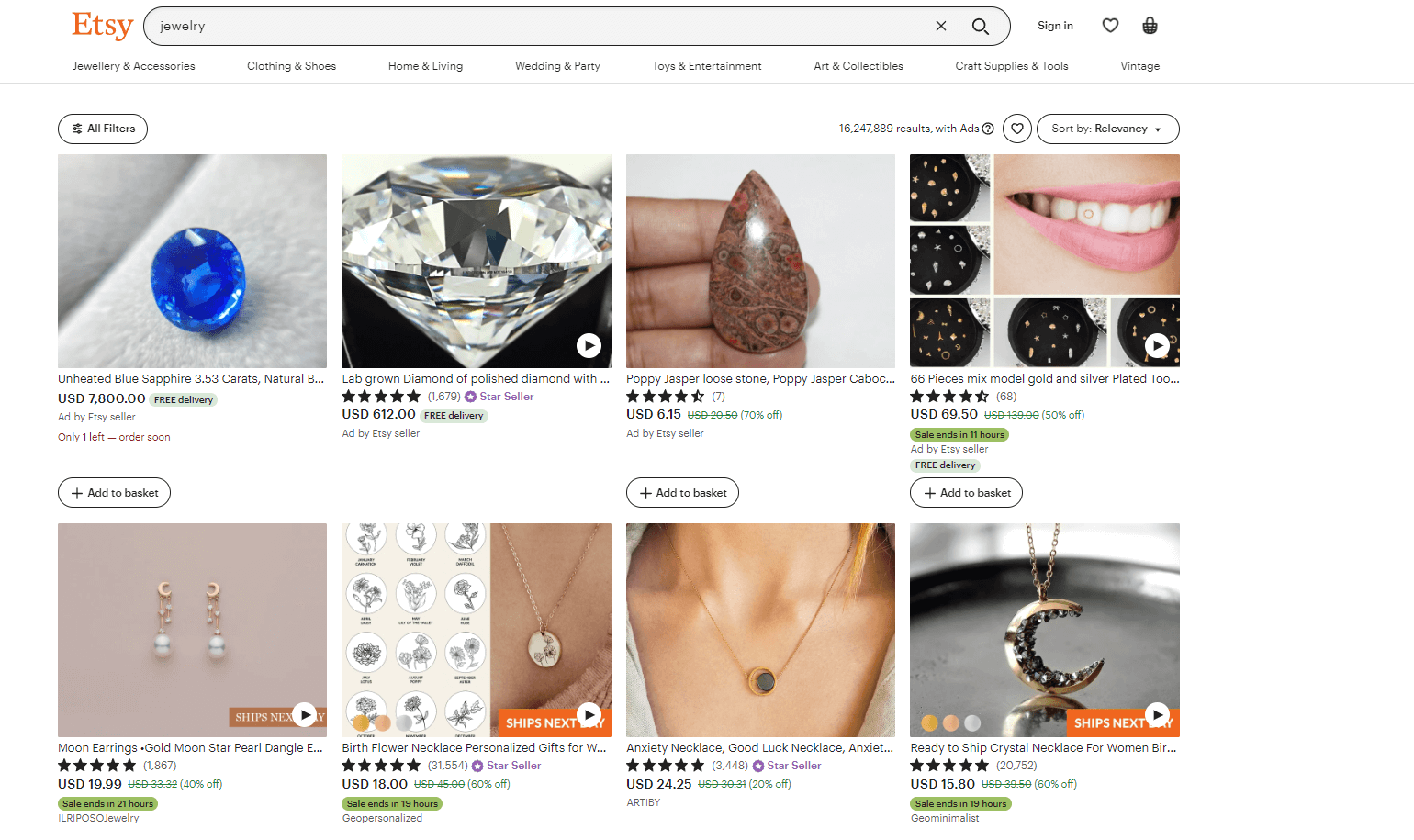
Step 3: Prepare Your Finances
If you’ve already figured out your business niche and game plan, the next step is to get your Etsy store up and running. Start by selecting the products you want to sell on Etsy.
To make your personal finance strategy work and start making money on Etsy, it’s crucial to calculate all your expenses and fees. This way, you can set the right profit margins for your items.
Etsy charges two main types of fees for each item you sell on their platform:
-
Listing Fee: Listing fees are straightforward. When you put a product up for sale on Etsy, there’s a flat fee of $0.20. This fee ensures your listing remains active for up to four months or until your item sells, whichever comes first.
-
Transaction Fee: Etsy’s transaction fee is 6.5% of the total cost of the sale. These fees are collected only when products in your Etsy shop are sold, and they are automatically deducted from your account after a purchase.
You might wonder why Etsy takes a cut of the shipping cost. This practice is in place to prevent sellers from offering low sale prices and then compensating for it by inflating the shipping cost. It ensures a level playing field for sellers and discourages fee avoidance tactics.
Step 4: Set Up Your Etsy Store
To become an Etsy seller, you’ll need to set up your own Etsy store. Here’s how to get started:
1. Sign Up or Log In
To become a seller, you must first have a regular Etsy account. If you don’t have one, you can create it at Etsy.com/Sell. Click on “Get Started” to begin. You can create your account using your email or through your existing Google, Facebook, or Apple account.
If you’ve shopped on Etsy before and already have an account, simply log in using your existing credentials. Then, select “Start your shop” to create your store.
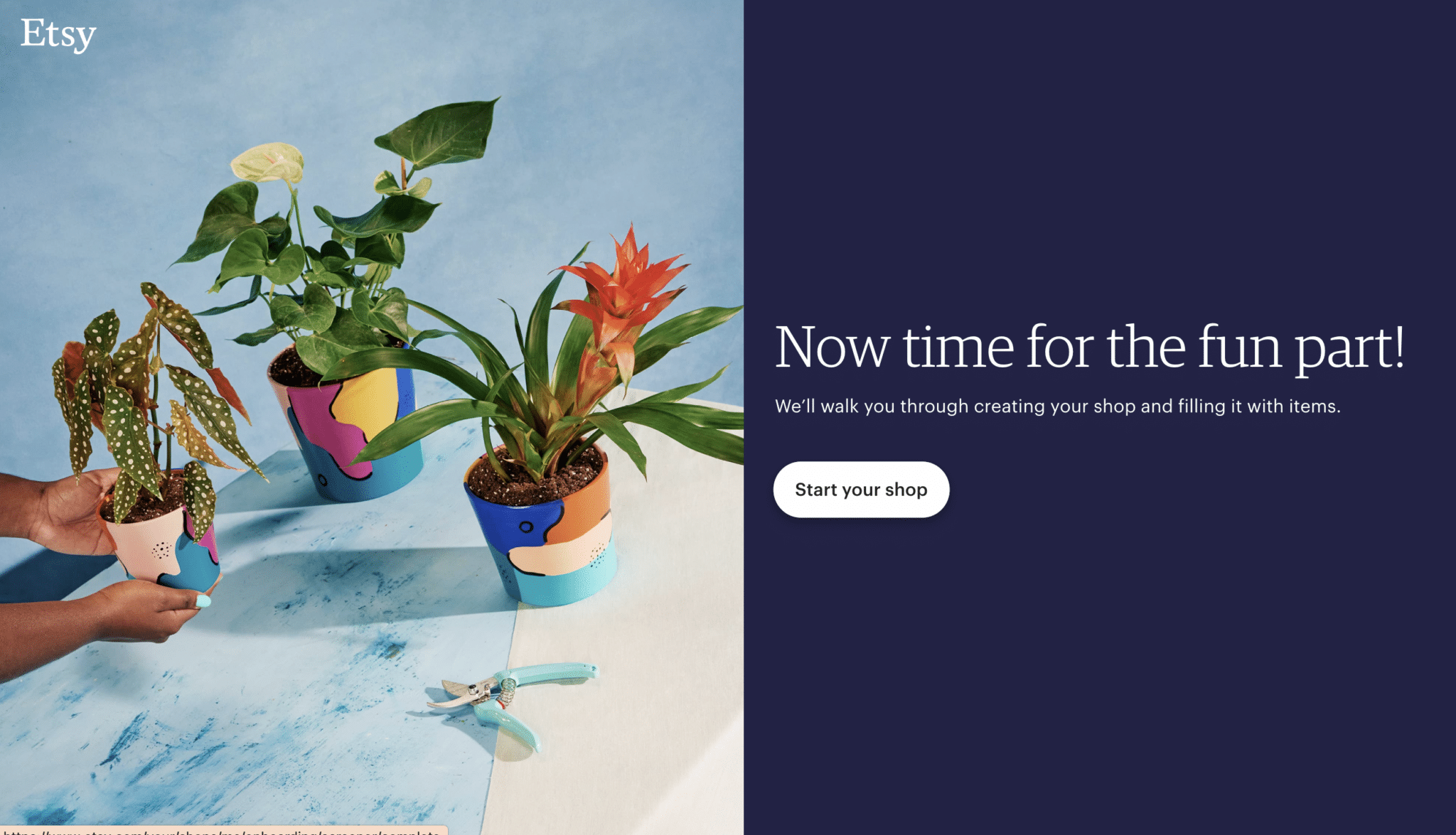
2. Provide Business Information (Optional)
You’ll be asked to share some details about your business, like how long you’ve been selling goods. Feel free to skip these questions if you prefer not to answer them.
3. Set Up Shop Preferences
On the “shop preferences” screen, you’ll configure some basic settings for your store. This includes selecting your default language, specifying your country of operation, and choosing the currency you’ll use for transactions.
Keep in mind that if you list products in a different currency than your Etsy Payments account, you’ll incur a 2.5% currency conversion fee on each sale.
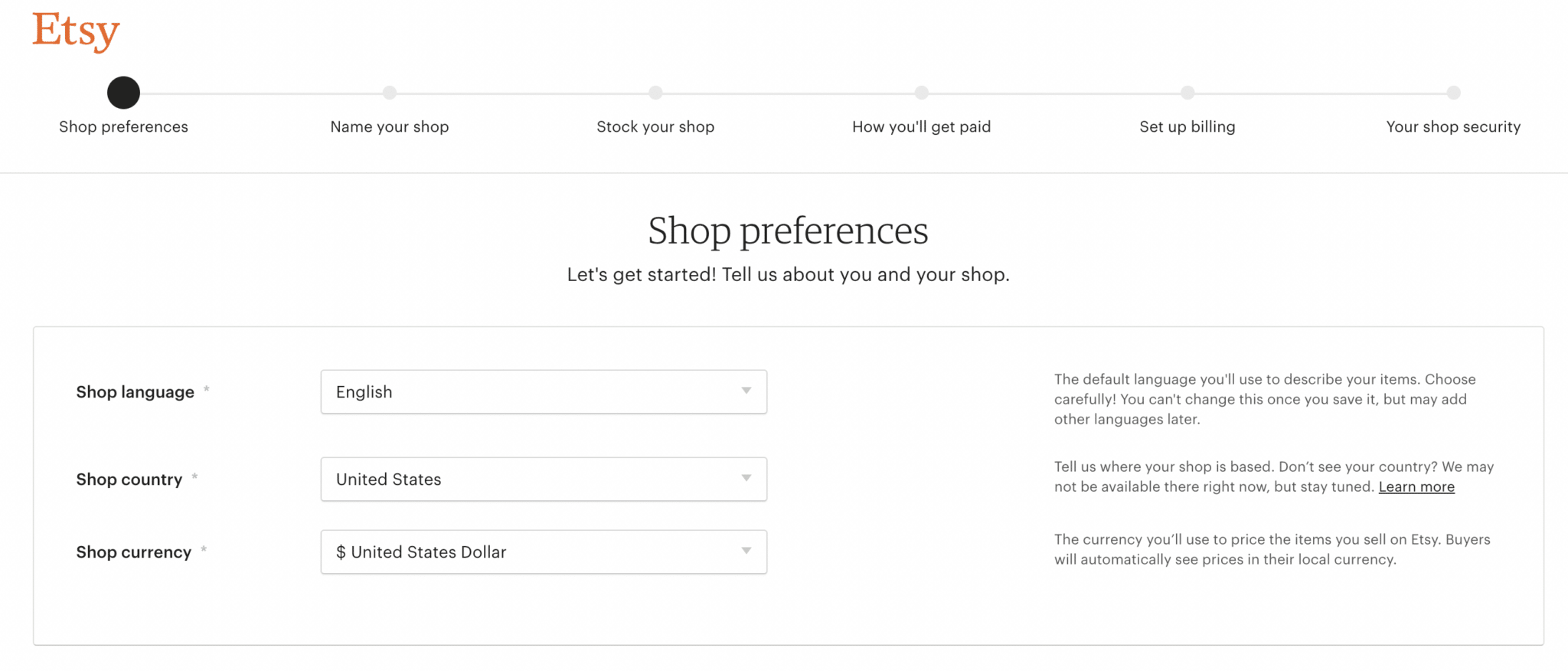
4. Choose Your Shop Name
Now comes the fun part – picking a name for your Etsy shop. Your shop name can be anything you like, but it must adhere to Etsy’s guidelines:
- Be between four to 20 characters long.
- Contain no spaces or special characters.
- Not already in use by another Etsy seller.
- Free of trademark infringements.
- Free of profanities.
You can change your shop name up to five times. After that, any changes will need to be reviewed and approved by Etsy Support.
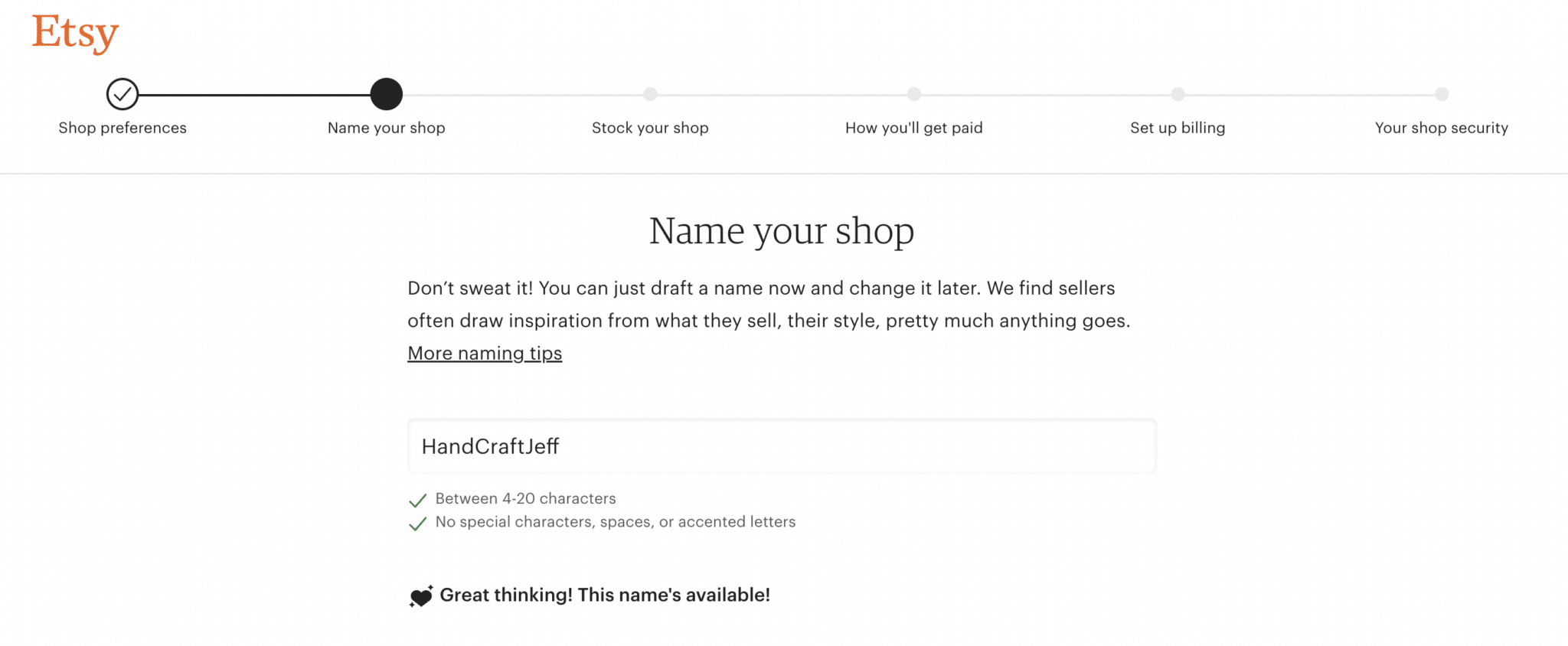
5. Create a Placeholder Listing
You need at least one listing to open your Etsy shop, but it doesn’t have to be your final product. For this quick setup guide, let’s create a fake placeholder listing so you can open your shop. Here’s what you need to include:
- One photo (you can download one from open-source image websites like Unsplash).
- Title.
- About this listing.
- Category.
- Description.
- Price.
- Shipping details.
You can simply put “test” in the title and description and choose random information for the rest of the fields.
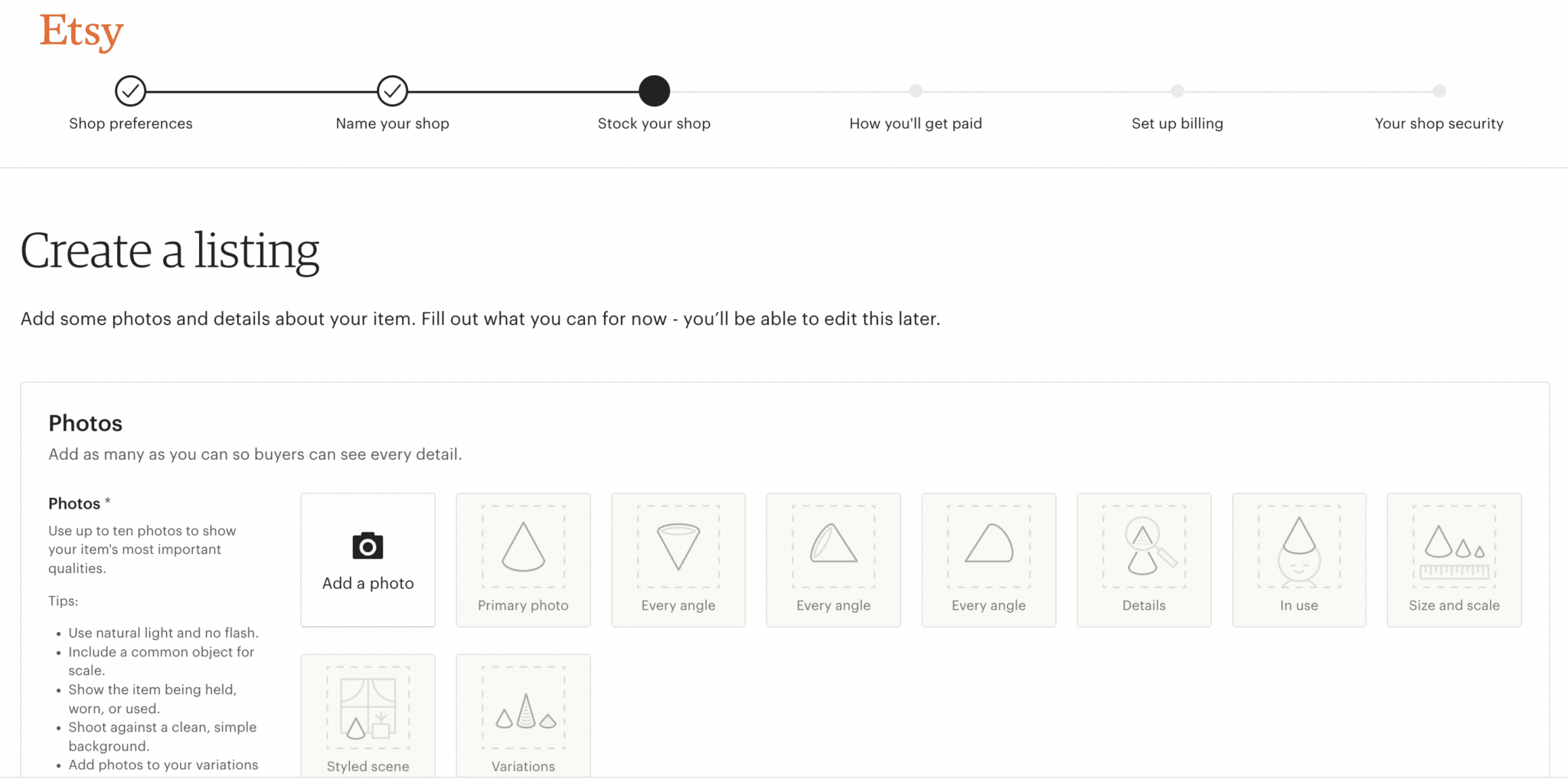
6. Enable Etsy Payments
Every new Etsy shop is required to use Etsy Payments when opening. Etsy Payments is Etsy’s payment processing system that accepts various payment methods, including credit cards, debit cards, PayPal, and installment payments through companies like Klarna.
7. Customize Your Shop
Now that your Etsy shop is up and running, take some time to complete the essential sections to provide a great shopping experience for your customers:
- Review and adjust shop policies.
- Set up accurate shipping profiles.
- Brand your shop by uploading a shop icon and shop banner.
- Add an “About” section.
- Create a shop announcement.
Step 5: Promote Your Etsy Shop
Now that your Etsy store is up and running, it’s time to get the word out and attract customers. Think about your ideal customers. Who are they? What are their interests, ages, locations, and spending habits? Understanding your target audience will help you tailor your products and listings to their preferences.
While Etsy does bring in some traffic, successful marketing can significantly boost your store’s visibility. Here are some marketing channels to consider:
-
Email Marketing: Create compelling email campaigns to engage existing and potential customers. Build an email list and send out promotions, deals, updates on sales, new products, and captivating content.
-
Etsy SEO: Optimize your listings with high-ranking keywords, meta tags, titles, and backlinks to improve your search engine ranking. Make it easier for people to discover your store and products when they search for similar items.
-
Social Media: Promote your products and store on platforms like Facebook, TikTok, Instagram, and more. Leverage current trends to create attention-grabbing posts, videos, and reels. Don’t forget to use relevant hashtags for discoverability.
-
Online Advertising: Utilize banners, pop-ups, and other display advertising methods to direct people to your store with a single click. Craft enticing titles and ad copy to make your store irresistible.
-
Content Marketing: Create informative blog posts, videos, articles, and more that provide valuable information about your products. Share updates, news, product reviews, deals, and features to engage your audience.
-
Influencer Marketing: Collaborate with influencers for reviews, affiliate partnerships, sponsored posts, giveaways, and other strategies to drive traffic to your store. Let others spread the word about your brand and share in the profits.
- Etsy Ads: Etsy offers in-platform advertising through promoted listings. You can boost your store’s visibility by paying for these ads. Etsy charges based on a bidding system for each click. You set your budget and bid price, and Etsy promotes your listings accordingly.
As your business expands, it’s essential to set specific sales goals and use Etsy’s web analytics tool. This tool helps you determine whether your current marketing strategies are effective or if it’s time to experiment with new approaches. It’s all about keeping a close eye on your performance and making informed decisions to drive your success.

Pros of Selling on Etsy
1. Stand Out with Unique Handmade Products
Etsy is perfect for products that are one-of-a-kind or have a homemade touch. Unlike bigger sites like eBay, where price and location are top priorities, Etsy buyers value quality and uniqueness. This means your special creations can really shine on Etsy, no matter the price.
2. Personalized Branding and Flexible Selling
On Etsy, you can give your shop a personal touch. You can add a logo, banner, and description with links to your social media profiles. This helps you create a memorable brand that people will recognize. Unlike eBay, where seller pages are often plain, Etsy lets you make your shop uniquely yours. You can even set up your own .com web address through Etsy for a fee.
Etsy also makes it easy to sell personalized items, which can earn you more money. You can also create coupon codes to reward loyal customers or fans on social media. Plus, you can temporarily close your shop if you need a break, which is reassuring for loyal customers.
3. Reach a Global Audience
Many UK Etsy sellers find that a surprising number of their orders come from overseas, especially Australia and the US. Because Etsy buyers appreciate unique, handmade items, they’re often willing to wait for their purchases. This means there’s a bigger market out there for you, including customers from all over the world. Etsy can help you reach a global audience and expand your customer base.
Cons of Selling on Etsy
1. Payment Delays and Fees Management
While Etsy offers flexibility in choosing how often you receive your payments (monthly, weekly, fortnightly, or daily), there can be delays before the money actually reaches your bank account. This delay can be inconvenient, especially when you need to cover postage costs upfront.
Keeping track of various expenses like listing fees, commissions, and payment charges can become challenging once your shop is up and running. These costs accumulate and are deducted in a lump sum once a month. It’s essential to set aside money to cover these expenses and not treat everything you receive from Etsy as pure profit.
2. Disadvantages for UK Sellers
UK sellers on Etsy face certain disadvantages compared to their American counterparts.
Shipping times are often longer, postage costs can be higher, and prices are displayed in dollars ($6.20) for US buyers instead of pounds (£5). This discrepancy can impact your competitiveness and buyer experience.
3. Limited Control and Potential Restrictions
Having a store on Etsy comes with limitations. You won’t have complete control over every aspect of the store’s design and branding. Your ability to develop a highly personalized brand may be restricted.
It’s important to note that Etsy has the authority to suspend or remove your shop from the platform, although such actions typically occur only when rules are violated.
If you aspire to turn your Etsy store into a fully-fledged business, keep in mind that having your independent website is often seen as more “professional.” While Etsy is an excellent starting point, if your business takes off, you might consider migrating to your own platform for greater control and branding opportunities.
Is Selling on Etsy a Good Side Hustle?
If you’re considering Etsy as a side hustle, it’s important to set realistic expectations. Making a quick buck isn’t what Etsy is all about. It requires a significant investment of time and effort to create your products, set up your shop, take high-quality photos, and fine-tune your product titles and descriptions to make your items discoverable. As the marketplace grows, competition increases, which means it may take some time to make that first sale and gain momentum.
That said, many small shops still manage to earn a decent side income from their products. In fact, 75% of the shop owners I spoke to were either stay-at-home parents or held full-time jobs outside their Etsy endeavors. Only 25% considered their Etsy shop a full-time business.
Etsy shop owners fall into various categories when it comes to viewing their venture as a side hustle or a full-fledged career. The level of commitment, the income you generate, and how you define your shop’s goals are entirely up to you.
If you’re looking to earn a little extra cash and have a genuine passion for creativity, Etsy could be a rewarding side hustle for you. Just remember, it’s designed for people with passion and determination; it’s not for the faint of heart!
Read more: Best Side Hustle Ideas

Anthony Smith is an internet entrepreneur. He created the Side Hustle Ideas Database to help people find side hustles for making extra money, with the potential of turning into a full-time income.
After graduating from the University of Pennsylvania with a business degree, he gained business experience at a consulting firm. At the same time, he tried various side hustles including freelance writing, blogging, and eCommerce. He managed to turn his side hustles into a full-time business, earning over $3 million. Now, he enjoys financial freedom and travels around the world as a digital nomad.